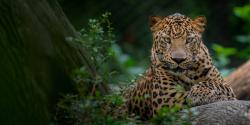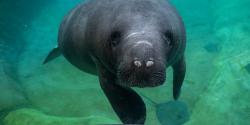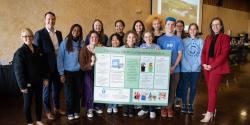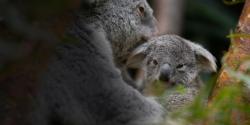NOTE TO MEDIA: Images and b-roll of the most recent greater one-horned rhino calf and his mother are available here. Photo credit can be found in the file names (example: Grahm S. Jones, Columbus Zoo and Aquarium). Video credit can be provided to the Columbus Zoo and Aquarium.
CUMBERLAND, Ohio — The Wilds is celebrating the birth of a second greater one-horned rhinoceros calf in just two months, marking another success in the conservation center’s ongoing commitment to wildlife preservation.
The male calf, who has not yet been named, was born on Saturday, November 25, 2023 to mother, Sanya. The Animal Management team reports that the calf appears to be strong and spends his time nursing, sleeping, exploring the rhino barn, and curiously observing other rhinos in adjacent areas. Sanya, who was born at the Toronto Zoo in 1999 and arrived at The Wilds in 2004, is an experienced mother. She continues to be patient and protective of her most recent calf, who is her seventh.
The calf’s father is 22-year-old Suru, who was born at the San Diego Zoo Safari Park in 2000. He came to The Wilds from Zoo Miami in 2021 per a breeding recommendation through the Species Survival Plan® (SSP), a program coordinated by the Association of Zoos and Aquariums (AZA) to maximize the genetic diversity and increase the population sustainability of threatened and endangered species in professional care. This is Suru’s sixth calf.
The calf is the 11th greater one-horned rhino born at The Wilds in its history. A female greater one-horned rhino calf was also born on September 22--World Rhino Day! The female calf, also sired by Suru, continues to be hand-reared by The Wilds’ dedicated Animal Management team. The team acted quickly when they noticed Anna, a first-time mother, was unable to care for her newborn and both required medical interventions. While Anna is now doing well after treatment for an infection, she did not show any interest in the calf during introductions at the rhino barn. The team will continue bottle-feeding the calf and providing her with essential care. Calves usually weigh more than 100 pounds at birth and gain a few pounds every day, eventually reaching 4,000-6,000 pounds as an adult. The calf is now already tipping the scales at 250 pounds! As the calf grows stronger, the team is working on a plan to integrate her with the herd so that despite the special attention she is receiving her human caregivers, she will have the opportunity to live and develop as a rhino.
Each greater one-horned rhino birth is a significant achievement for a species that nearly went extinct during the 20th century. The Wilds is home to seven greater one-horned rhinos and is one of only 17 AZA-accredited facilities in North America to care for this species.
The Wilds is also home to 17 southern white rhinos and has had a total of 30 white rhino births since 2004, with the most recent being a female born on September 23. The calf was born in the pasture to mother, Anan, and father, Kengele.
The Wilds is the first facility outside of Africa with white rhinos born four and five generations removed from their wild-born ancestors. White rhino calves are born after a gestation of 16 months and they can grow to be 5,000 pounds and 6 feet tall at their shoulder.
The International Union for the Conservancy of Nature and Natural Resources (IUCN) Red List of Threatened Species™ lists the greater one-horned rhino as Vulnerable while the southern white rhino remains classified as Near Threatened. In addition to challenges such as habitat degradation, poachers sell rhino horns for ornamental or traditional medicinal purposes even though there are no scientifically proven health benefits for their use. The horns are made of keratin — the same substance that makes up fingernails and hair.
As part of its continued commitment to protecting these species, The Wilds has teamed up with the Center for Conservation and Research of Endangered Wildlife (CREW) at the Cincinnati Zoo & Botanical Garden and other partner research facilities to form the American Institute of Rhinoceros Science (AIRS), a model for saving species with science ex situ (which means off site or outside natural habitat). The AIRS operations are based at The Wilds, and the initiative was made possible by a National Leadership Grant from the Institute of Museum and Library Services (IMLS). This collaboration strives to save rhinos through science by researching their physical condition, dietary needs, reproduction, and behavioral and environmental factors—all in an effort to maximize their wellbeing in professional care.
“We are proud of the success of The Wilds’ rhino program, and we are also uniquely positioned to be able to inspire others to take action to help rhinos by offering guests the opportunity to connect with these incredible species. Each calf offers much hope for the future of rhinos, and we remain committed to providing our experience and expertise to collaborative initiatives working to find solutions to conservation challenges to benefit rhinos and other wildlife,” said Dr. Joe Smith, Vice President of The Wilds.
Guests who visit The Wilds this winter season may have the opportunity to see the rhino calves in their barns during the Rhino Barn Tours and Winter Wildside Tours. Winter Wildside Tours are presented by AEP Ohio.
For more information about The Wilds’ conservation initiatives, educational offerings, how to become a member, or to schedule a tour, please visit TheWilds.org and follow The Wilds’ social media accounts on Facebook, Instagram, X, and TikTok.
###
About The Wilds
The Wilds sits on almost 10,000 acres of lush landscapes along the Appalachian Byway and attracts nearly 120,000 visitors annually. With the mission of Empowering People. Saving Wildlife., The Wilds is among one of the largest, cutting-edge conservation centers in North America and is home to more than 500 animals representing 28 rare and endangered species from around the world. The Wilds operates tours, overnight accommodations, special events, and summer camps as a source of revenue. The Wilds is located at 14000 International Road in Cumberland, Ohio, about 90 minutes east of Columbus. The Wilds is open year round, with a full line of tour options running from May through October and specialty tours available from November through April. For more information, visit TheWilds.org.









